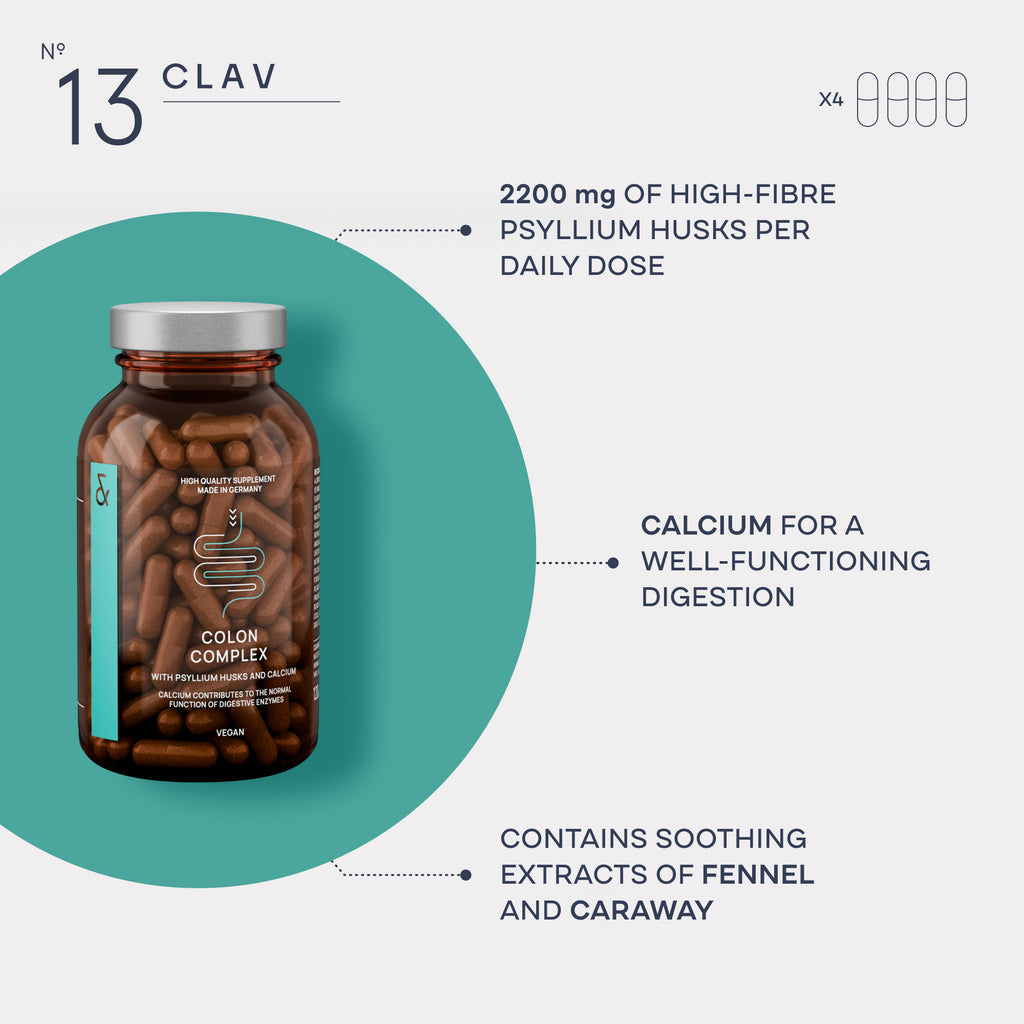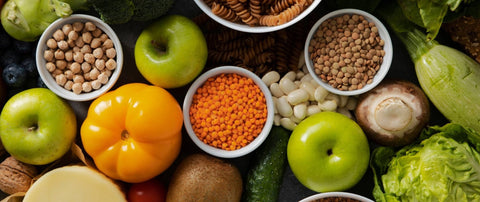Fibres are essential to any balanced diet. They are not only useful, but actually very healthy. In this article, you can find out why they are so important for your diet and health and how you can integrate enough fibre into your diet.
Inhaltsverzeichnis
What exactly is fibre?
Dietary fibre refers to the components of food that cannot be processed in our bodies. We often encounter some dietary fibres as additives that are used as thickeners in foods, among other things. The most common are xanthan gum, carrageenan and pectin, which are found in gummy bears, oat drinks and jams, for example. Dietary fibres are particularly suitable as thickeners because of their swelling properties, which also benefit our digestion.
The role of dietary fibre for digestion
The swelling capacity of dietary fibres, i.e. their ability to bind large amounts of water, is an important aspect of their significance for digestion and health. If they are ingested with food, their volume in the stomach increases. This exerts a certain amount of pressure on the stomach wall, which reduces the release of the appetite-stimulating hormone ghrelin. This means that fibre-rich food makes us feel full more quickly.
The swelling of fibre also has a positive effect on the intestines. The pressure that the chyme exerts on the intestinal wall stimulates the movement of the intestine, known as intestinal peristalsis. This ensures that the food moves faster in the intestine and is therefore excreted more quickly.
There are no enzymes in our digestive tract that break down fibre so that it can be absorbed through the intestinal wall. Nevertheless, we can certainly benefit from them, more specifically our intestinal microbiome. The bacteria that live in our digestive tract can make good use of fibre. They ferment these fibres, producing important fatty acids, which in turn provide them with energy. As "food" for the beneficial intestinal bacteria, fibre therefore ensures greater diversity in the microbiome and promotes a healthy balance of the various bacterial strains.6,7 The British government recommends that adults consume at least 30g of fibre per day. However, the reality is that no age group in the UK consumes more than 20g of fibre per day.8 For 30g of fibre, for example, you would have to eat 300g of oatmeal, 200g of chickpeas or 30g of dried figs. Of course, the 30g per day should ideally come from different sources.

Health benefits of dietary fibre
It is undisputed that fibre is part of a balanced and healthy diet. However, research is also being carried out in various fields into the connection between increased fibre intake and some diseases that pose major problems in our Western society. Of course, this does not mean that fibre can protect you from these diseases or even cure them. But there are perhaps good reasons to pay a little more attention to eating enough fibre.
A high-fibre diet and the risk of cancer
Various studies suggest a link between increased fibre intake and a reduced risk of bowel cancer.1,2. This could be due to the positive effects on the intestinal flora, the shorter dwell time in the intestine and thus shorter exposure of the intestinal mucosa to various toxins.
Of course, it must be assumed that people who eat a healthy diet rich in fibre also pay more attention to their health in other respects. High-fibre foods often displace other, less healthy foods from the diet. For example, someone who eats a lot of vegetables and wholemeal products is likely to eat less white flour and red meat. Nevertheless, the researchers in the relevant studies have come to the conclusion that dietary fibre has a positive effect in terms of cancer prevention.
Fibre to help with obesity and diabetes
Several studies have recorded significant weight loss with the supplementation of inulin, glucomannan and psyllium husks. The test subjects who were given a breakfast with these supplements were more satisfied afterwards and did not get hungry again as quickly as the control group without fibre. The energy content, i.e. the calorie content, was not higher in the fibre group.9,4. Obesity and the associated secondary diseases such as diabetes, cardiovascular diseases and heart attacks are among the most common causes of death in industrialised countries.
High-fibre foods cause blood sugar levels to rise only slowly after eating. This is a huge advantage over simple carbohydrates or sugar, which lead to a rapid rise in blood sugar levels. This was the reason for some researchers to take a closer look at the connection between fibre intake and diabetes. It turned out that fasting glucose levels were lower with a higher fibre intake, and cholesterol levels also improved significantly with a diet higher in fibre.
The "Western diet" and its consequences
The term "Western diet" is widely used in medical and nutritional circles. In general, this refers to a diet that involves eating a lot of high-fat, highly processed and high-sugar foods such as fast food and convenience products. When people began to farm, food became more accessible. With the industrial revolution, calorie intake soon exceeded actual energy requirements. Over the centuries, this was compounded by increased stress, smoking, pollution, a lot of sitting and little exercise. In anthropological terms, these changes occurred relatively quickly, so our bodies and our gene pool have not yet had time to adapt to the changed circumstances. In combination with our significantly longer life expectancy, these circumstances have led to the so-called lifestyle diseases.6 These include diabetes, high blood pressure, obesity and various types of cancer, as well as mental illnesses such as depression, anxiety and eating disorders. Although a diet rich in processed foods and sugar is common, it's not the best choice for your body.

Ad
These five foods are the highest in fibre
As you can see, it's worth taking a close look at your eating habits. Do you often keep eating even when you're already full? Do you grab a snack from the kitchen more often during the day? How much fibre from different sources do you get on average? We have picked out the five foods with the highest fibre content for you. If you try to always include at least one of the following five groups in your meals, you're on the right track.
1. Psyllium husks & co
They are the absolute front runners when it comes to fibre content. As psyllium husks are neutral in taste, they are ideal as a topping for muesli or yoghurt bowls. Wheat bran, chia or linseed are similarly high in fibre. However, they have the disadvantage that they are not gluten-free (wheat bran) or neutral in flavour.
2. Pulses
Beans, lentils and peas are also rich in fibre. As they are also rich in protein and many other important nutrients, they should be an integral part of your diet. Just as you can make hummus from chickpeas, you can turn any pulses into a delicious dip. This keeps things varied and interesting in terms of flavour. The only important thing is that you soak them for several hours or overnight before processing them. This sometimes requires a little planning.
3. Cereal
All cereals contain fibre, but just like the other vitamins, this is found in the outer layers of the grain. This is why wholemeal products are always richer in fibre compared to processed cereal products made from white flour. Pseudo-cereals such as buckwheat, millet or quinoa are also high in fibre and are a good alternative to side dishes such as rice or potatoes. What's more, they are all gluten-free and therefore particularly gentle on your gut.
4. Nuts
In addition to valuable fatty acids and vitamins, nuts also contain important fibre. Pumpkin seeds, almonds and sunflower seeds can also be integrated into many dishes. Whether roasted as a salad or soup topping or pureed as the base of a creamy dip - nuts are really versatile. With nuts and dates, you can also easily whip up energy balls and have a healthy snack when you feel a craving for something sweet.
5. Dried fruit
As the moisture has been removed from them, dried fruit has a very high fibre content. This is why prunes, for example, are considered a household remedy for constipation. They should therefore not be eaten in excess. However, you can add raisins, apricots or figs to your muesli as a sweet kick. Dates are also great in pureed form as a sugar substitute in most baking recipes. Why not give it a try?
Food should not be a stress factor
With all the tips and recommendations on nutrition and health that are out there, it is important that you don't allow yourself to become stressed or even lose the joy of eating. Nobody manages to eat a perfectly balanced diet all the time and not indulge in some small sins. Food is also important for the mind, and if you sometimes need that one recipe from your childhood, even though it goes against all the rules of healthy eating, then that's perfectly fine. But if you keep a few suggestions in mind, maybe the next time you go to the supermarket you'll reach for a higher-fibre alternative or perhaps try that recipe with that one vegetable you've always been so suspicious of.
Sources
- Gianfredi V, Nucci D, Salvatori T, Dallagiacoma G, Fatigoni C, Moretti M, Realdon S. Rectal Cancer: 20% Risk Reduction Thanks to Dietary Fibre Intake. Systematic Review and Meta-Analysis. Nutrients. 2019 Jul 12;11(7):1579. doi: 10.3390/nu11071579. PMID: 31336939; PMCID: PMC6683071. https://www.ncbi.nlm.nih.gov/pmc/articles/PMC6683071/
- Park SY, Wilkens LR, Kolonel LN, Henderson BE, Le Marchand L. Inverse associations of dietary fiber and menopausal hormone therapy with colorectal cancer risk in the Multiethnic Cohort Study. Int J Cancer. 2016 Sep 15;139(6):1241-50. doi: 10.1002/ijc.30172. Epub 2016 May 14. PMID: 27137137; PMCID: PMC5503506. https://www.ncbi.nlm.nih.gov/pmc/articles/PMC5503506/
- Reynolds AN, Akerman AP, Mann J. Dietary fibre and whole grains in diabetes management: Systematic review and meta-analyses. PLoS Med. 2020 Mar 6;17(3):e1003053. doi: 10.1371/journal.pmed.1003053. PMID: 32142510; PMCID: PMC7059907. https://www.ncbi.nlm.nih.gov/pmc/articles/PMC7059907/
- Pokushalov E, Ponomarenko A, Garcia C, Pak I, Shrainer E, Seryakova M, Johnson M, Miller R. The Impact of Glucomannan, Inulin, and Psyllium Supplementation (SolowaysTM) on Weight Loss in Adults with FTO, LEP, LEPR, and MC4R Polymorphisms: A Randomized, Double-Blind, Placebo-Controlled Trial. Nutrients. 2024 Feb 17;16(4):557. doi: 10.3390/nu16040557. PMID: 38398881; PMCID: PMC10892568. https://www.ncbi.nlm.nih.gov/pmc/articles/PMC10892568/
- Farvid MS, Cho E, Eliassen AH, Chen WY, Willett WC. Lifetime grain consumption and breast cancer risk. Breast Cancer Res Treat. 2016 Sep;159(2):335-45. doi: 10.1007/s10549-016-3910-0. Epub 2016 Aug 10. PMID: 27510186; PMCID: PMC5014619. https://www.ncbi.nlm.nih.gov/pmc/articles/PMC5014619/
- Malesza IJ, Malesza M, Walkowiak J, Mussin N, Walkowiak D, Aringazina R, Bartkowiak-Wieczorek J, Mądry E. High-Fat, Western-Style Diet, Systemic Inflammation, and Gut Microbiota: A Narrative Review. Cells. 2021 Nov 14;10(11):3164. doi: 10.3390/cells10113164. PMID: 34831387; PMCID: PMC8619527. https://pubmed.ncbi.nlm.nih.gov/34831387/
- Fu J, Zheng Y, Gao Y, Xu W. Dietary Fiber Intake and Gut Microbiota in Human Health. Microorganisms. 2022 Dec 18;10(12):2507. doi: 10.3390/microorganisms10122507. PMID: 36557760; PMCID: PMC9787832. https://www.ncbi.nlm.nih.gov/pmc/articles/PMC9787832/
- https://www.gov.uk/government/news/gc-and-ifst-publish-information-statement-on-dietary-fibre
- Jenko Pražnikar Z, Mohorko N, Gmajner D, Kenig S, Petelin A. Effects of Four Different Dietary Fibre Supplements on Weight Loss and Lipid and Glucose Serum Profiles during Energy Restriction in Patients with Traits of Metabolic Syndrome: A Comparative, Randomized, Placebo-Controlled Study. Foods. 2023 May 24;12(11):2122. doi: 10.3390/foods12112122. PMID: 37297364; PMCID: PMC10253086. https://www.ncbi.nlm.nih.gov/pmc/articles/PMC10253086/
- Elena Jovanovski, Rana Khayyat, Andreea Zurbau, Allison Komishon, Nourah Mazhar, John L. Sievenpiper, Sonia Blanco Mejia, Hoang Vi Thanh Ho, Dandan Li, Alexandra L. Jenkins, Lea Duvnjak, Vladimir Vuksan; Should Viscous Fiber Supplements Be Considered in Diabetes Control? Results From a Systematic Review and Meta-analysis of Randomized Controlled Trials. Diabetes Care 1 May 2019; 42 (5): 755–766. https://doi.org/10.2337/dc18-1126




 DE-ÖKO-006
DE-ÖKO-006
